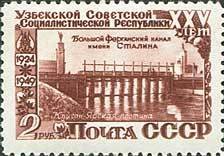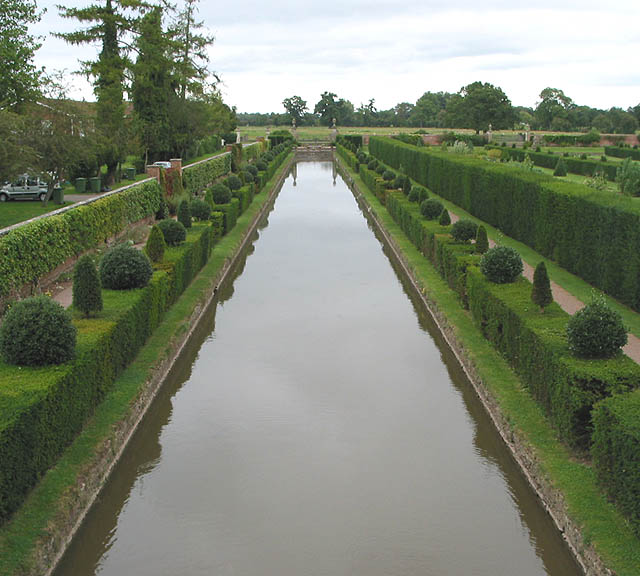Stamp: Kuigan-Yar dam of The Great Fergana Canal n.a. Stalin (Soviet Union, USSR 1950)
Kuigan-Yar dam of The Great Fergana Canal n.a. Stalin (Soviet Union, USSR 1950)
03 January (Soviet Union, USSR ) within release 25th anniversary of Uzbek SSR. goes into circulation Stamp Kuigan-Yar dam of The Great Fergana Canal n.a. Stalin face value 2 Russian ruble
| Stamp Kuigan-Yar dam of The Great Fergana Canal n.a. Stalin in catalogues | |
|---|---|
| Michel: | Mi:SU 1437 |
Stamp is horizontal format.
Also in the issue 25th anniversary of Uzbek SSR.:
- Stamp - Teacher's training college in Tashkent face value 20;
- Stamp - The Navoi State Theatre for Opera and Ballet in Tashkent face value 25;
- Stamp - Navoi Street in Tashkent face value 40;
- Stamp - Government House and Statue of Vladimir Lenin in Tashkent face value 40;
- Stamp - Kuigan-Yar dam of The Great Fergana Canal n.a. Stalin face value 2;
- Stamp - Map of The Great Fergana Canal named after Stalin face value 1;
Stamp Kuigan-Yar dam of The Great Fergana Canal n.a. Stalin it reflects the thematic directions:
A head of state (or chief of state) is the public persona that officially represents the national unity and legitimacy of a sovereign state. In some countries, the head of state is a ceremonial figurehead with limited or no executive power, while in others, the head of state is also the head of government. In countries with parliamentary governments, the head of state is typically a ceremonial figurehead that does not actually guide day-to-day government activities and may not be empowered to exercise any kind of secular political authority (e.g., Queen Elizabeth II as Head of the Commonwealth). In countries where the head of state is also the head of government, the president serves as both a public figurehead and the actual highest ranking political leader who oversees the executive branch (e.g., the President of the United States).
An economy is an area of the production, distribution and trade, as well as consumption of goods and services. In general, it is defined as a social domain that emphasize the practices, discourses, and material expressions associated with the production, use, and management of resources. A given economy is a set of processes that involves its culture, values, education, technological evolution, history, social organization, political structure, legal systems, and natural resources as main factors. These factors give context, content, and set the conditions and parameters in which an economy functions. In other words, the economic domain is a social domain of interrelated human practices and transactions that does not stand alone.
A statue is a free-standing sculpture in which the realistic, full-length figures of persons or animals are carved or cast in a durable material such as wood, metal or stone. Typical statues are life-sized or close to life-size. A sculpture that represents persons or animals in full figure, but that is small enough to lift and carry is a statuette or figurine, whilst those that are more than twice life-size are regarded as colossal statues.
A dam is a barrier that stops or restricts the flow of surface water or underground streams. Reservoirs created by dams not only suppress floods but also provide water for activities such as irrigation, human consumption, industrial use, aquaculture, and navigability. Hydropower is often used in conjunction with dams to generate electricity. A dam can also be used to collect or store water which can be evenly distributed between locations. Dams generally serve the primary purpose of retaining water, while other structures such as floodgates or levees (also known as dikes) are used to manage or prevent water flow into specific land regions.
Flora is the plant life occurring in a particular region or time, generally the naturally occurring or indigenous—native plant life. The corresponding term for animal life is fauna. Flora, fauna and other forms of life such as fungi are collectively referred to as biota. Sometimes bacteria and fungi are also referred to as flora, as in the terms gut flora or skin flora.
Canals or artificial waterways are waterways or engineered channels built for drainage management (e.g. flood control and irrigation) or for conveyancing water transport vehicles (e.g. water taxi). They carry free, calm surface flow under atmospheric pressure, and can be thought of as artificial rivers
Государственный деятель или государственная женщина — это политик или лидер организации, который имеет долгую и уважаемую карьеру на национальном или международном уровне или в определенной области.
An anniversary is the date on which an event took place or an institution was founded in a previous year, and may also refer to the commemoration or celebration of that event. For example, the first event is the initial occurrence or, if planned, the inaugural of the event. One year later would be the first anniversary of that event. The word was first used for Catholic feasts to commemorate saints. Most countries celebrate national anniversaries, typically called national days. These could be the date of independence of the nation or the adoption of a new constitution or form of government. The important dates in a sitting monarch's reign may also be commemorated, an event often referred to as a "Jubilee".







